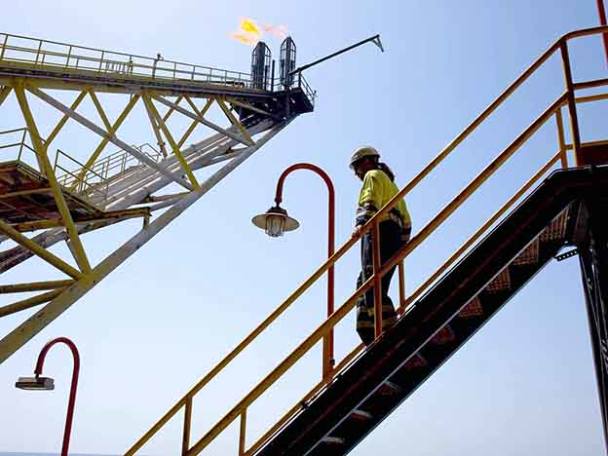Stop us if you’ve heard this one before. Cairn Energy (CNE) boasts profitable, multi-year production growth, a strong balance sheet, a potential arbitration dispute windfall, and a share price that trades well below the value of its resource-based net asset value. If this sounds familiar, it is because we highlighted these strengths when we made the FTSE 250 oil and gas group our 2017 Value Tip of the Year. Yet the company’s shares are basically flat on that call, despite good operational progress and a steady rebalance in the oil market that should have improved sentiment for all energy stocks.
Oil price at $65
Production on stream
Robust balance sheet
Potential dispute windfall
No dividend
Project sanction risks
The bump in Brent crude prices around the time of our recommendation at the start of this year always risked facing some resistance. Last month’s rollover of an important agreement to freeze output, brokered by Russia and Saudi Arabia, will no doubt come in for the same doubts as US rigs re-mobilise. Any uncertainty is a negative for a stock like Cairn, much of whose value is tied to the prospect that its long-dated offshore assets will be developed. And without a dividend to speak of, Cairn has been unable to compete for investment capital seeking income, which has been better directed to the likes of BP (BP.) and Royal Dutch Shell (RDSB).
Beneath an indifferent market remains a strong investment case. First, production is set to grow at a clip, and in the near term those increases are set to come from the North Sea. Sure, first oil from the Kraken field, in which Cairn holds a 29.5 per cent working interest, arrived with teething problems related to control systems on the production rig. But this was down to poor expectation management from field operator EnQuest (ENQ), which at the end of November reported the field plan was back on schedule, and that gross rates of output had hit 40,000 barrels of oil a day (bopd).
This will very soon be supplemented by oil and gas from Catcher, operated by another heavily indebted mid-tier player, Premier Oil (PMO). Based on the estimates of analysts at Numis Securities, Cairn’s 20 per cent working interest in the field should entitle it to 10,100 boepd in 2018. Against a forecast oil price of $62, that should provide Cairn with $111m of post-tax cash flow next year. And alongside profitable output from Kraken, that’s the sort of earnings growth profile we think will put Cairn back on the radar of energy investors hungry for cash flows.
The second catalyst investors can expect in 2018 is a final investment decision and development concept for Cairn’s Sangomar Deep (or 'SNE') discovery offshore Senegal. Exploration at the field has yielded 11 successful wells in the past three years, and represents potential gross resources of as much as 1bn barrels of oil equivalent. According to analysts at Macquarie Research, the field should be highly commercial at low oil prices – potentially returning a free cash flow yield of 29 per cent a year once on stream.
Here, the fate of the oil price does carry weight. So long as Cairn has a floor of $60 a barrel, it can pay for the project out of its own funds; a slump in prices may necessitate a farm-out deal. Nevertheless, Sangomar won’t be productive until at least 2021, meaning Cairn has lots of options and time to bring costs down as far as possible. Although the development of large offshore fields has been the industry’s largest casualty of the past three years, lessons learned by the majors should be passed on to operators keen to put their deep-water projects in the money.
The final reason why things should be different this time relates to a settlement of a long-running, high-value tax dispute. To recap on this drawn-out saga, Cairn believes it has been unfairly impacted by India’s decision to block the disposal of a residual 10 per cent stake in Cairn India dating back to 2011. Cairn has a “high level of confidence” that its application for $1.1bn compensation plus costs will be recognised by an international arbitration panel when it hears the case in the spring. A windfall of this magnitude, equivalent to 115p a share in Numis’s estimation and largely absent from Cairn’s valuation, could be mired in lengthy counter appeals. But we are hopeful that the panel will return a favourable judgement when the case concludes, possibly in August next year.
| CAIRN ENERGY (CNE) | ||||
| ORD PRICE: | 209p | MARKET VALUE: | £1.22bn | |
| TOUCH: | 208.8-209p | 12-MONTH HIGH: | 251p | LOW: 164p |
| FORWARD DIVIDEND YIELD: | NIL | FORWARD PE RATIO: | 15 | |
| NET ASSET VALUE: | 396¢ | NET CASH: | $232m | |
| Year to 31 Dec | Turnover ($m) | Pre-tax profit ($m) | Earnings per share (¢) | Dividend per share (¢) |
| 2014 | nil | -559 | -67.0 | nil |
| 2015 | nil | -498 | -90.3 | nil |
| 2016 | nil | -152 | -16.5 | nil |
| 2017* | 52 | 223 | 43.4 | nil |
| 2018* | 555 | 164 | 19.1 | nil |
| % change | +10 | +16 | +17 | - |
| Normal market size: | 10,000 | |||
| Matched bargain trading | ||||
| Beta: | 1.08 | |||
| £1=$1.34 *Numis forecasts | ||||











